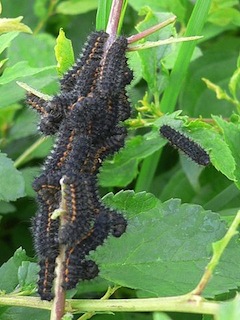The spectacular Emperor moth is on the wing in April and May.
Photo: Emily Hobson
Scientific name: Saturnia pavonia
Cornish name: ‘Gouwan’ is the general word for moth
What to look for:
- Colouring: Both sexes in the adult have prominent eye spots. Males are patterned in grey and brown with orange hindwings, while the larger female is patterned in white and grey. The caterpillars, when fully grown, are green, and have black bands and either pink or orange-coloured spots tufted with black hairs.
- Size: 55 to 80 mm wingspan (females are larger).
- Where: Distributed widely across Britain. The adult flight period is April to May. Females are active by night, whereas the males fly by day, searching for resting females. Mainly seen in relatively open habitat, such as scrub, heathland or woodland rides. The caterpillars can be spotted on the various foodplants (see text below).
 The spectacular Emperor moth is on the wing for only two months, in April and May. The males are active by day, flying fast in their search for females to mate with. The females rest by day, attracting males using scent glands: the males can detect the powerful pheromones from up to a mile away, using their feathery antennae, and several may swarm around a female until one succeeds in mating. The night-flying females then lay batches of eggs on the stems of the larval foodplants: these include meadowsweet, heather, birch, hawthorn, blackthorn and bramble.
The spectacular Emperor moth is on the wing for only two months, in April and May. The males are active by day, flying fast in their search for females to mate with. The females rest by day, attracting males using scent glands: the males can detect the powerful pheromones from up to a mile away, using their feathery antennae, and several may swarm around a female until one succeeds in mating. The night-flying females then lay batches of eggs on the stems of the larval foodplants: these include meadowsweet, heather, birch, hawthorn, blackthorn and bramble.
The distinctive caterpillars, black-banded and with pink or orange spots with black tufts of hair, can be seen through most of the summer. They initially feed in groups. The larvae overwinter as pupae, emerging as adults in April of the following year.
Did you know…?
…Emperor moths do not feed as adults during their relatively short flight period
…The Emperor is the only moth of the Saturniidae family resident in Britain, of which there are over 2000 described worldwide
More information and references:
Chinery, M., 2005. Collins Complete Guide to British Insects. Collins, London.
Waring, P., Townsend, M. and Lewington, R., 2009. Field Guide to the Moths of Great Britain and Ireland (second edition). British Wildlife Publishing, Gillingham, Dorset.
Published: April 2017
Author: Amanda Scott
Photos: Adult moth (Emily Hobson, taken at Windmill Farm); caterpillars (Wikimedia Commons – CC BY-SA 3.0)
